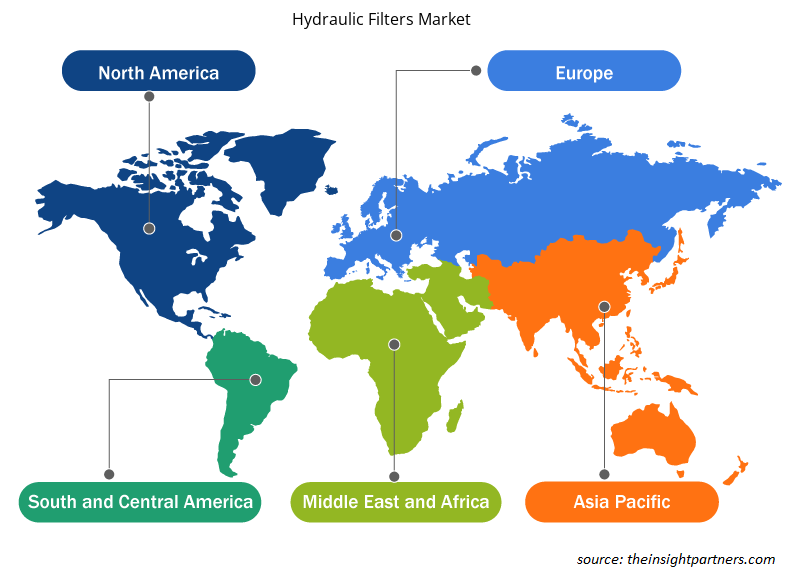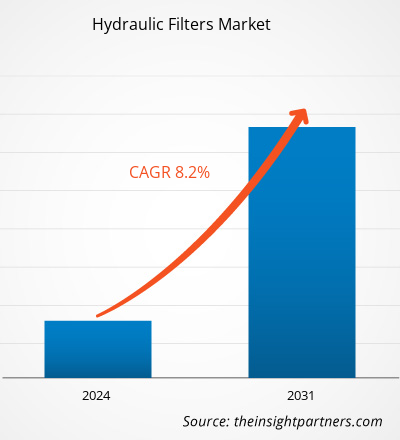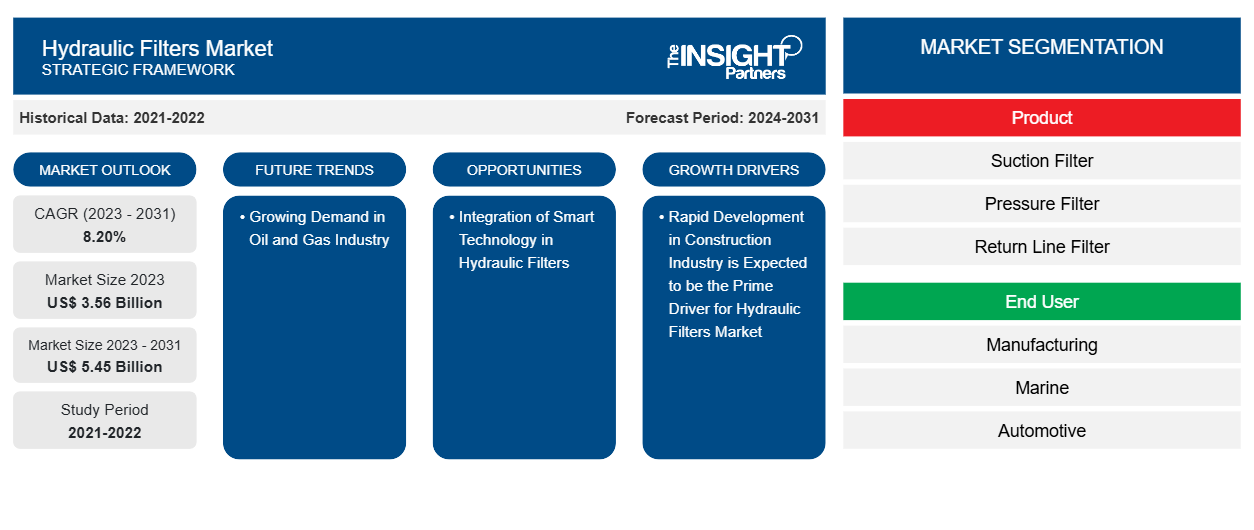La taille du marché des filtres hydrauliques devrait atteindre 5,45 milliards USD d’ici 2031, contre 3,56 milliards USD en 2023. Le marché devrait enregistrer un TCAC de 8,20 % en 2023-2031. L’application croissante des filtres hydrauliques dans les secteurs de la fabrication, de la construction et des transports devrait propulser la croissance du marché des filtres hydrauliques au cours de la période de prévision.
Analyse du marché des filtres hydrauliques
Les filtres hydrauliques sont très mobiles et nécessitent moins de temps d'installation sur divers sites de fabrication et de construction. Les filtres hydrauliques permettent de trier l'huile pour éliminer la saleté et les éléments. L'efficacité opérationnelle du filtre hydraulique est évaluée par la vitesse à laquelle la contamination, comme une capacité élevée de rétention de la saleté, est efficacement éliminée. En croissance. Les secteurs en constante évolution des mines, de la pétrochimie et des machines de construction ont augmenté la demande de filtres hydrauliques dans toutes les grandes économies. Les ventes de filtres hydrauliques sont encore stimulées par des facteurs tels que l'expansion des activités industrielles et l'urbanisation croissante, ainsi que par une augmentation de l'utilisation en aval et une demande croissante de pétrole dans de nombreux pays. Les préoccupations croissantes concernant l'efficacité des opérations dans les industries ont élargi le commerce des filtres hydrauliques, ce qui, à son tour, stimule la croissance du marché mondial des filtres hydrauliques.
Aperçu du marché des filtres hydrauliques
La production croissante de véhicules au niveau mondial stimule la demande de filtres hydrauliques. Les facteurs restrictifs, tels que le processus d'installation compliqué des filtres hydrauliques, peuvent entraver la croissance du marché mondial des filtres hydrauliques au cours de la période de prévision. La numérisation a augmenté la compétence des machines existantes et devrait augmenter la demande de filtres hydrauliques à l'échelle mondiale. En outre, les activités minières croissantes et le développement des infrastructures devraient stimuler le développement du marché des filtres hydrauliques au cours de la période de prévision.
Personnalisez ce rapport en fonction de vos besoins
Vous bénéficierez d'une personnalisation gratuite de n'importe quel rapport, y compris de certaines parties de ce rapport, d'une analyse au niveau des pays, d'un pack de données Excel, ainsi que d'offres et de remises exceptionnelles pour les start-ups et les universités.
-
Obtenez les principales tendances clés du marché de ce rapport.Cet échantillon GRATUIT comprendra une analyse de données, allant des tendances du marché aux estimations et prévisions.
Moteurs et opportunités du marché des filtres hydrauliques
Le développement rapide du secteur de la construction devrait être le principal moteur du marché des filtres hydrauliques
Les filtres hydrauliques contribuent au bon fonctionnement des machines de construction et fonctionnent avec une large gamme de pompes, de vannes et d'actionneurs. Les investissements substantiels dans le développement des infrastructures par les gouvernements du monde entier augmentent simultanément la demande d'équipements hydrauliques tels que les pompes, les vérins, les moteurs, les vannes, les groupes électrogènes et les filtres. Ainsi, le développement rapide du secteur de la construction devrait propulser la croissance du marché des filtres hydrauliques au cours de la période de prévision.
Intégration de la technologie intelligente dans les filtres hydrauliques
La pénétration des appareils compatibles IoT dans les secteurs résidentiel, commercial et industriel augmente à l'échelle mondiale. En conséquence, les fabricants de filtres hydroniques fournissent à leurs clients des solutions uniques et développent des filtres hydroniques intelligents qui peuvent être intégrés à une infrastructure intelligente. Les filtres hydroniques intelligents utilisent les fonctionnalités d'Internet, telles que les capacités d'analyse des données de surveillance en temps réel pour améliorer l'efficacité opérationnelle.
Analyse de segmentation du rapport sur le marché des filtres hydrauliques
Les segments clés qui ont contribué à l’élaboration de l’analyse du marché des filtres hydrauliques sont le produit et l’utilisateur final.
- En fonction du produit, le marché des filtres hydrauliques a été divisé en filtre d'aspiration, filtre à pression, filtre de retour, filtre hors ligne, filtre de reniflard et autres. Le segment des filtres de retour détenait une part de marché plus importante en 2023.
- En termes d'utilisateur final, le marché a été segmenté en secteurs manufacturier, maritime, automobile, chimique et pétrochimique, production d'énergie , agriculture, construction, métallurgie et mines, etc. Le segment manufacturier a dominé le marché en 2023.
Analyse des parts de marché des filtres hydrauliques par géographie
La portée géographique du rapport sur le marché des filtres hydrauliques est principalement divisée en cinq régions : Amérique du Nord, Europe, Asie-Pacifique, Moyen-Orient et Afrique et Amérique du Sud.
L'Amérique du Nord a dominé le marché des filtres hydrauliques en 2023. La région Amérique du Nord comprend les États-Unis, le Canada et le Mexique. La croissance du marché des filtres hydrauliques en Amérique du Nord est attribuée au développement croissant du secteur de la construction ainsi qu'à la demande croissante de filtres hydrauliques dans le secteur manufacturier, ce qui contribue à la croissance du marché des filtres hydrauliques en Amérique du Nord. Les filtres hydrauliques sont largement utilisés dans les environnements à haut risque, tels que la récupération de pétrole et de gaz, les opérations minières et les chantiers de construction. Le soutien croissant du gouvernement par le biais d'incitations et de subventions a un impact positif sur le marché en Amérique du Nord.
Aperçu régional du marché des filtres hydrauliques
Les tendances régionales et les facteurs influençant le marché des filtres hydrauliques tout au long de la période de prévision ont été expliqués en détail par les analystes d’Insight Partners. Cette section traite également des segments et de la géographie du marché des filtres hydrauliques en Amérique du Nord, en Europe, en Asie-Pacifique, au Moyen-Orient et en Afrique, ainsi qu’en Amérique du Sud et en Amérique centrale.

- Obtenez les données régionales spécifiques au marché des filtres hydrauliques
Portée du rapport sur le marché des filtres hydrauliques
| Attribut de rapport | Détails |
|---|---|
| Taille du marché en 2023 | 3,56 milliards de dollars américains |
| Taille du marché d'ici 2031 | 5,45 milliards de dollars américains |
| Taux de croissance annuel composé mondial (2023-2031) | 8,20% |
| Données historiques | 2021-2022 |
| Période de prévision | 2024-2031 |
| Segments couverts |
Par produit
|
| Régions et pays couverts |
Amérique du Nord
|
| Leaders du marché et profils d'entreprises clés |
|
Densité des acteurs du marché des filtres hydrauliques : comprendre son impact sur la dynamique commerciale
Le marché des filtres hydrauliques connaît une croissance rapide, tirée par la demande croissante des utilisateurs finaux en raison de facteurs tels que l'évolution des préférences des consommateurs, les avancées technologiques et une plus grande sensibilisation aux avantages du produit. À mesure que la demande augmente, les entreprises élargissent leurs offres, innovent pour répondre aux besoins des consommateurs et capitalisent sur les tendances émergentes, ce qui alimente davantage la croissance du marché.
La densité des acteurs du marché fait référence à la répartition des entreprises ou des sociétés opérant sur un marché ou un secteur particulier. Elle indique le nombre de concurrents (acteurs du marché) présents sur un marché donné par rapport à sa taille ou à sa valeur marchande totale.
Les principales entreprises opérant sur le marché des filtres hydrauliques sont :
- Filtration Hengst
- Société Donaldson, Inc.
- Eaton Corporation Plc
- Groupe de filtration industrielle
- HYDAC
Avis de non-responsabilité : les sociétés répertoriées ci-dessus ne sont pas classées dans un ordre particulier.

- Obtenez un aperçu des principaux acteurs du marché des filtres hydrauliques
Actualités et développements récents du marché des filtres hydrauliques
Le marché des filtres hydrauliques est évalué en collectant des données qualitatives et quantitatives après des recherches primaires et secondaires, qui comprennent des publications d'entreprise importantes, des données d'association et des bases de données. Voici une liste des développements sur le marché des filtres hydrauliques et des stratégies :
- En juillet 2020, Hengst Filtration a acquis l'activité de filtration hydraulique de Bosch Rexroth. (Source : Hengst Filtration, Communiqué de presse/Site Internet de l'entreprise/Newsletter)
- En avril 2024, Eaton Corporation a élargi sa gamme de produits d'unités de filtration hors ligne pour la filtration des fluides hydrauliques avec une solution mobile et portable, le filtre mobile UM 15. (Source : Eaton Corporation, communiqué de presse/site Web de l'entreprise/bulletin d'information)
Rapport sur le marché des filtres hydrauliques : couverture et livrables
Le rapport « Taille et prévisions du marché des filtres hydrauliques (2021-2031) » fournit une analyse détaillée du marché couvrant les domaines ci-dessous :
- Taille du marché et prévisions aux niveaux mondial, régional et national pour tous les segments de marché clés couverts par le périmètre
- Dynamique du marché, comme les facteurs moteurs, les contraintes et les opportunités clés
- Principales tendances futures
- Analyse PEST détaillée
- Analyse du marché mondial et régional couvrant les principales tendances du marché, les principaux acteurs, les réglementations et les développements récents du marché
- Analyse du paysage industriel et de la concurrence couvrant la concentration du marché, l'analyse de la carte thermique, les principaux acteurs et les développements récents
- Profils d'entreprise détaillés avec analyse SWOT
- Analyse historique (2 ans), année de base, prévision (7 ans) avec TCAC
- Analyse PEST et SWOT
- Taille du marché Valeur / Volume - Mondial, Régional, Pays
- Industrie et paysage concurrentiel
- Ensemble de données Excel
Rapports récents
Témoignages
Raison d'acheter
- Prise de décision éclairée
- Compréhension de la dynamique du marché
- Analyse concurrentielle
- Connaissances clients
- Prévisions de marché
- Atténuation des risques
- Planification stratégique
- Justification des investissements
- Identification des marchés émergents
- Amélioration des stratégies marketing
- Amélioration de l'efficacité opérationnelle
- Alignement sur les tendances réglementaires























 Obtenez un échantillon gratuit pour - Marché des filtres hydrauliques
Obtenez un échantillon gratuit pour - Marché des filtres hydrauliques